The Seasonic PRIME Titanium PSU (650W, 750W, 850W) Review: Mythical Performance
by E. Fylladitakis on April 7, 2017 9:00 AM ESTHot Test Results
The electrical performance of the new Seasonic PRIME Titanium units is unbelievable. We are unsure how Seasonic even managed such power quality and performance figures.
| Seasonic SSR-650TD - Main Output | ||||||||
| Load (Watts) | 130.29 W | 325.85 W | 488.11 W | 650.38 W | ||||
| Load (Percent) | 20.04% | 50.13% | 75.09% | 100.06% | ||||
| Amperes | Volts | Amperes | Volts | Amperes | Volts | Amperes | Volts | |
| 3.3 V | 1.78 | 3.34 | 4.45 | 3.34 | 6.67 | 3.33 | 8.89 | 3.33 |
| 5 V | 1.78 | 5.03 | 4.45 | 5.03 | 6.67 | 5.01 | 8.89 | 5.01 |
| 12 V | 9.6 | 12.02 | 24.01 | 12.02 | 36.01 | 12.01 | 48.02 | 12 |
| Line | Regulation (20% to 100% load) |
Voltage Ripple (mV) | |||||
| 20% Load | 50% Load | 75% Load | 100% Load | CL1 12V |
CL2 3.3V + 5V |
||
| 3.3V | 0.2% | 4 | 4 | 6 | 8 | 4 | 6 |
| 5V | 0.25% | 4 | 6 | 6 | 8 | 4 | 6 |
| 12V | 0.15% | 4 | 4 | 6 | 8 | 6 | 6 |
| Seasonic SSR-750TD - Main Output | ||||||||
| Load (Watts) | 150.34 W | 375.71 W | 562.75 W | 750.4 W | ||||
| Load (Percent) | 20.05% | 50.09% | 75.03% | 100.05% | ||||
| Amperes | Volts | Amperes | Volts | Amperes | Volts | Amperes | Volts | |
| 3.3 V | 1.81 | 3.33 | 4.53 | 3.33 | 6.8 | 3.33 | 9.07 | 3.33 |
| 5 V | 1.81 | 5.02 | 4.53 | 5.02 | 6.8 | 5.01 | 9.07 | 5.01 |
| 12 V | 11.25 | 12.02 | 28.11 | 12.02 | 42.17 | 12 | 56.23 | 12 |
| Line | Regulation (20% to 100% load) |
Voltage Ripple (mV) | |||||
| 20% Load | 50% Load | 75% Load | 100% Load | CL1 12V |
CL2 3.3V + 5V |
||
| 3.3V | 0.2% | 4 | 4 | 6 | 8 | 4 | 6 |
| 5V | 0.25% | 4 | 6 | 6 | 10 | 4 | 6 |
| 12V | 0.18% | 4 | 4 | 6 | 8 | 6 | 8 |
| Seasonic SSR-850TD - Main Output | ||||||||
| Load (Watts) | 170.49 W | 426.27 W | 638.38 W | 851.07 W | ||||
| Load (Percent) | 20.06% | 50.15% | 75.1% | 100.13% | ||||
| Amperes | Volts | Amperes | Volts | Amperes | Volts | Amperes | Volts | |
| 3.3 V | 1.84 | 3.34 | 4.6 | 3.34 | 6.91 | 3.33 | 9.21 | 3.33 |
| 5 V | 1.84 | 5.04 | 4.6 | 5.04 | 6.91 | 5.02 | 9.21 | 5.02 |
| 12 V | 12.89 | 12.03 | 32.23 | 12.03 | 48.35 | 12.01 | 64.46 | 12.01 |
| Line | Regulation (20% to 100% load) |
Voltage Ripple (mV) | |||||
| 20% Load | 50% Load | 75% Load | 100% Load | CL1 12V |
CL2 3.3V + 5V |
||
| 3.3V | 0.2% | 4 | 4 | 6 | 8 | 4 | 8 |
| 5V | 0.25% | 4 | 6 | 8 | 10 | 6 | 8 |
| 12V | 0.15% | 4 | 4 | 8 | 10 | 8 | 6 |
We had to check our readings down to the fourth decimal point, as the voltage regulation on the main 12V line is below 0.15%, meaning that a cheap 2-decimal point voltmeter might not even display a difference at all across the entire load range. The 3.3V/5V lines are a little less tightly regulated but still remain amongst the most stable that we have ever seen, with our worst result being 0.24% for the 5V line of the 850W model.
The power quality of all three PRIME Titanium units is insanely good, with our oscilloscope never reading a voltage ripple above 10mV under any operating conditions. We have never seen such effective filtering before on consumer level products.
Despite the exceptional efficiency of the PSUs, the fans are significantly more lively with the units operating into our hotbox, as the thermal control circuit is trying to maintain low internal operating temperatures. The PRIME Titanium units all begin with noise figures when lightly loaded but their fans will keep increasing their speed alongside with the load, reaching clearly audible figures with loads above 300 Watts and even becoming noisy with >46 dB(A) figures when they units are very heavily loaded. The maximum temperature that our instruments recorded was just below 80 °C, which is very low for an 850W PSU operating at maximum capacity, meaning that Seasonic could trade some of the thermal performance for better acoustics. These units do come with a 12-year warranty though, so the designer could perhaps not afford >90°C figures appearing into any of these units.



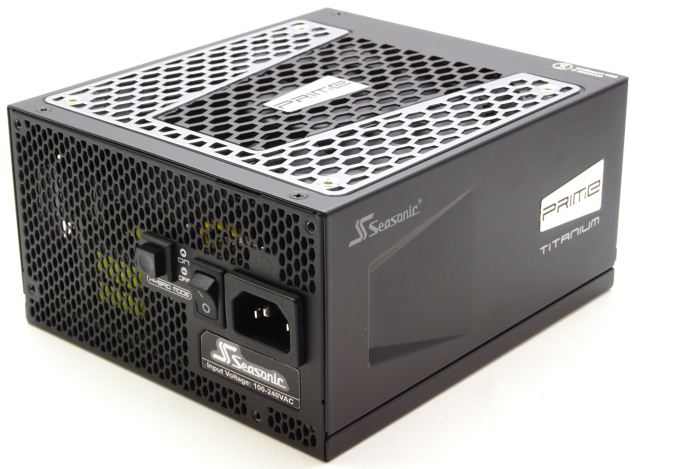
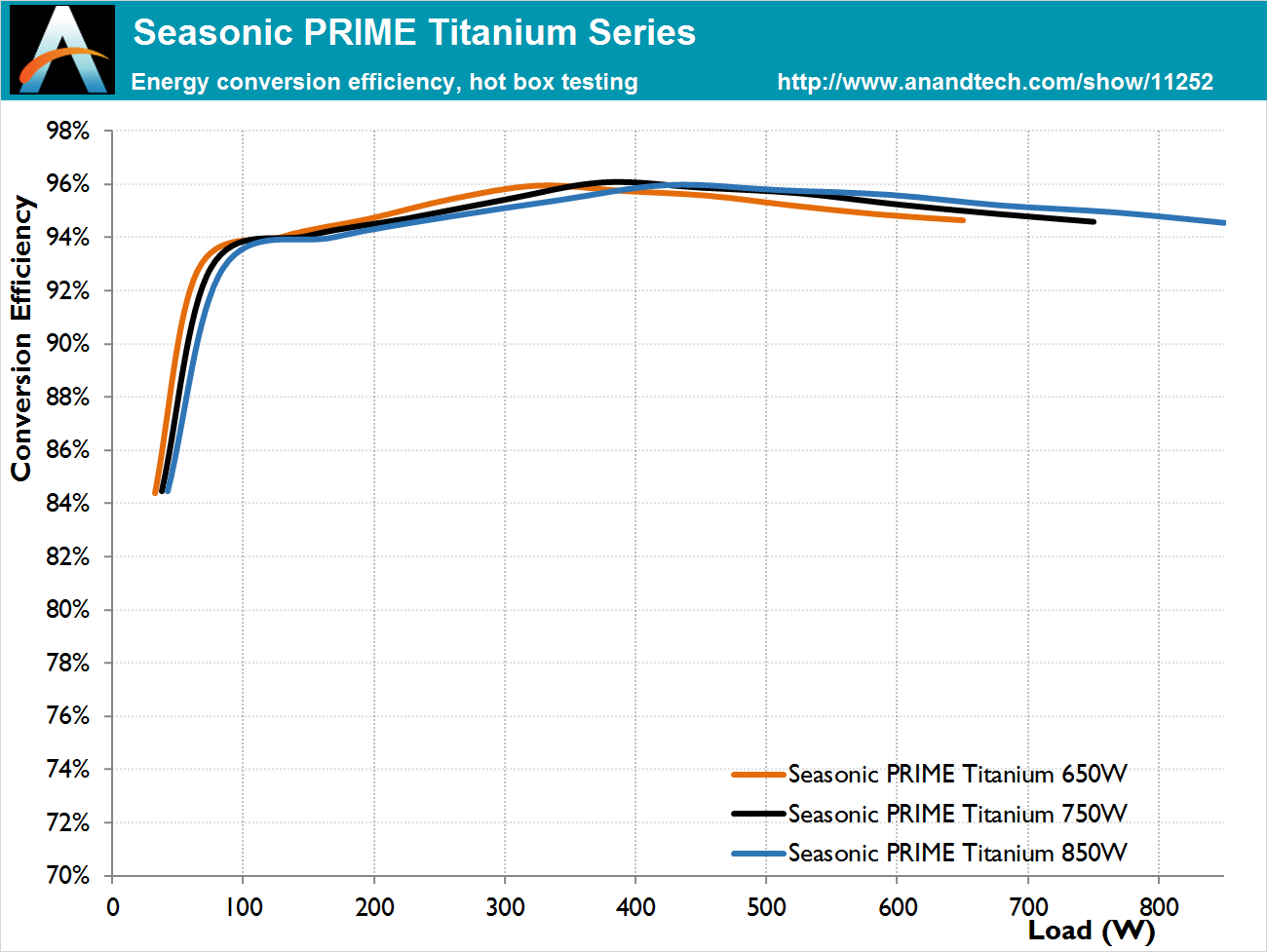
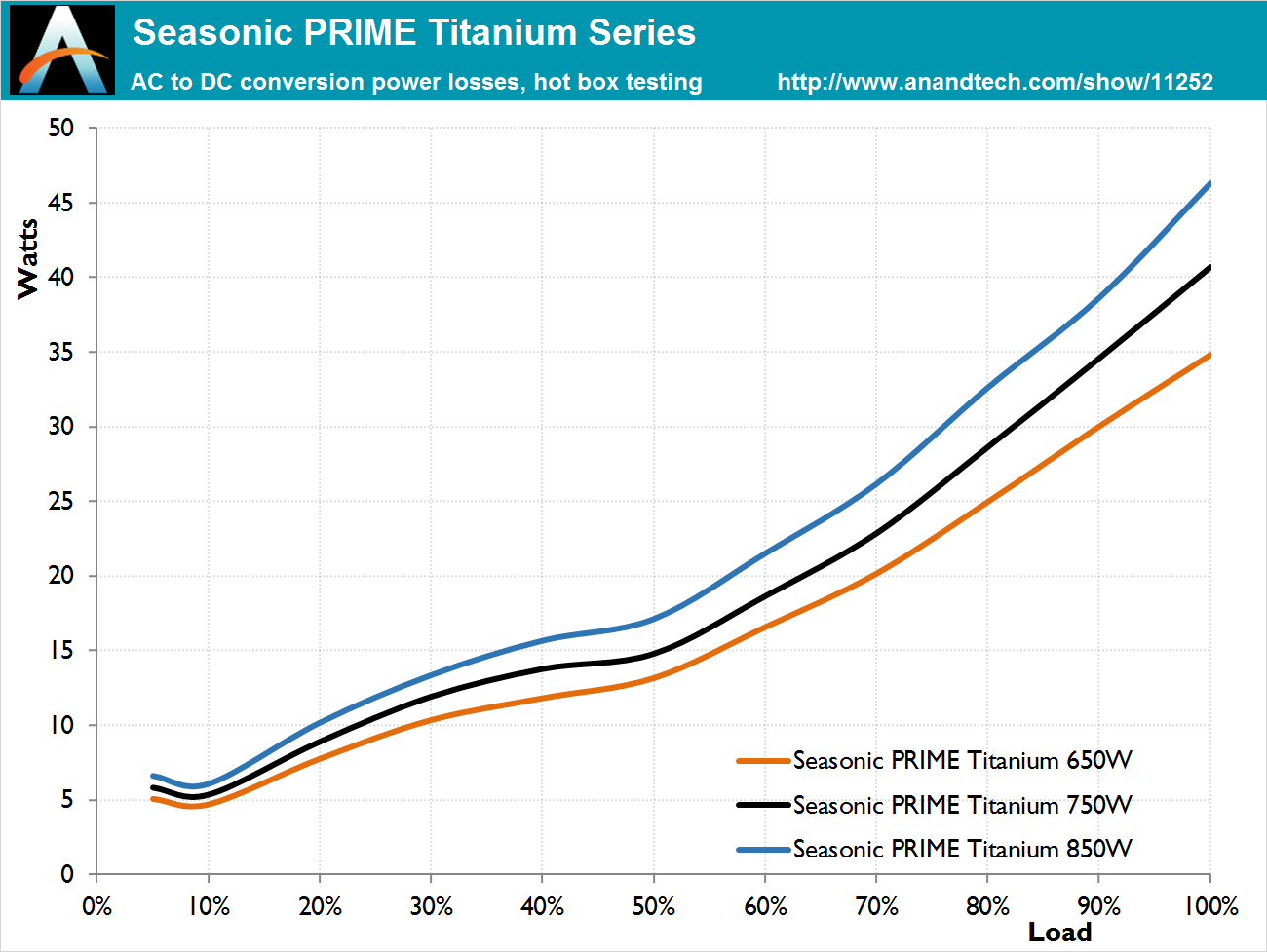

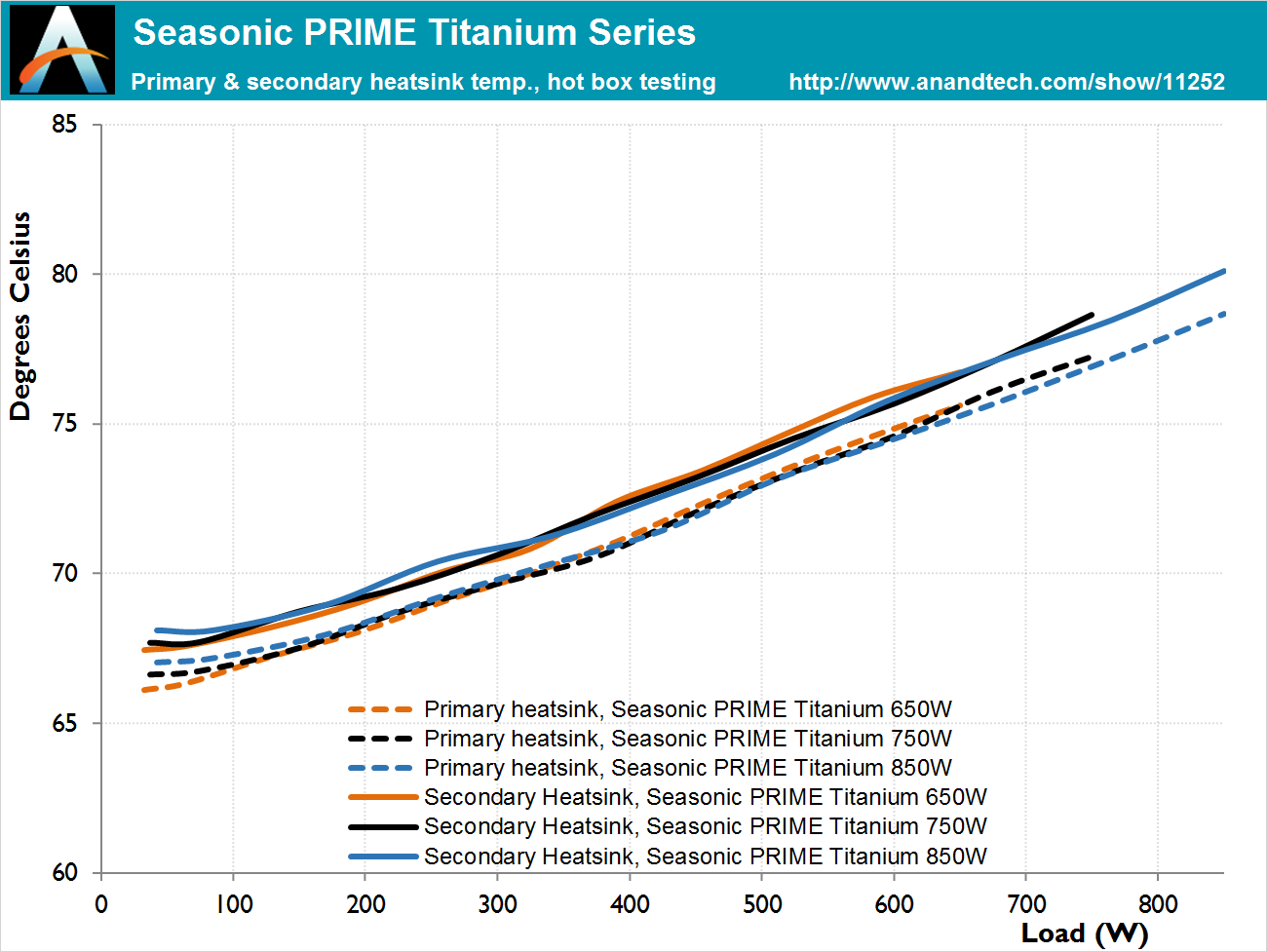
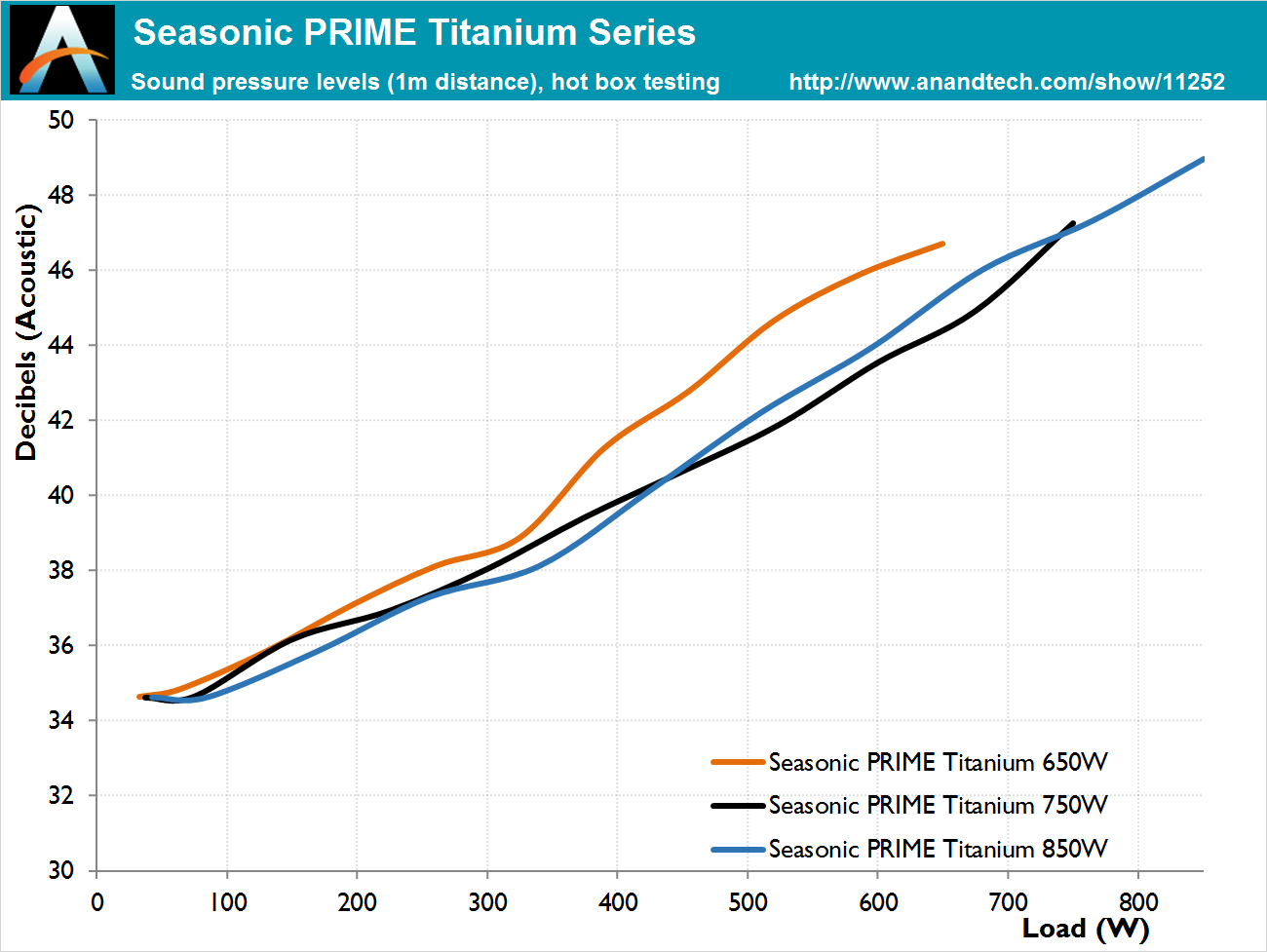








86 Comments
View All Comments
blahsaysblah - Saturday, April 8, 2017 - link
Your math??Platinum only has guarantee for 20% and above, for a 850W PS at 20% load that is 170 Watts. Platinum guarantees 90% efficiency at 20% load so 170Watt load from PC would draw 189W at wall.
Titanium adds a 10% load guarantee threshold of 90% efficiency, so a 850W PS need a 85W(95W at wall) load to 170W(185W at wall, titanium gives 92% at 20%) load.
Exodite - Friday, April 7, 2017 - link
Any word on the pricing of the fanless 600W unit?I've been using a 400W fanless gold unit for quite some time and while I expect it to last many years still it's nice to have options.
It's unfortunate, if understandable, that the high-end supplies come with such high wattages as efficiency suffers under low load scenarios.
oranos - Friday, April 7, 2017 - link
seasonic #1jabber - Friday, April 7, 2017 - link
Isn't it time we moved to some newer and more compact power connectors for motherboards? The current selection are very 1980's.JasperJanssen - Saturday, April 8, 2017 - link
No, it really isn't time to move to more compact connectors. For the amount of power you need to transfer, it doesn't really get much more compact.Byte - Sunday, April 9, 2017 - link
That's what iMacs are for.lordken - Saturday, April 8, 2017 - link
you aren't really a tech guy are you?Don't fix whats not broken. Why change power connectors as they fulfill their purpose just good? What would be benefit of such more compact redesign? That they look better? lol give me a break
And if it is disgrace for your sight to look at them, you only need to do it once when you build PC. Hope you can manage.
Go and buy yourself new phone or fancy toy to satisfy your thirst for modernity...geez
surt - Sunday, April 9, 2017 - link
There are also those niggly laws of physics to deal with.robotmaster0 - Sunday, April 9, 2017 - link
Funny you would say that since the 80's mainboard connectors (AT - 2x6pin Molex) were smaller then our big modern ones (ATX). Of course I would not want to be constrained to AT power requirements.jpak725 - Saturday, April 8, 2017 - link
if only seasonic made sfx psus of this quality